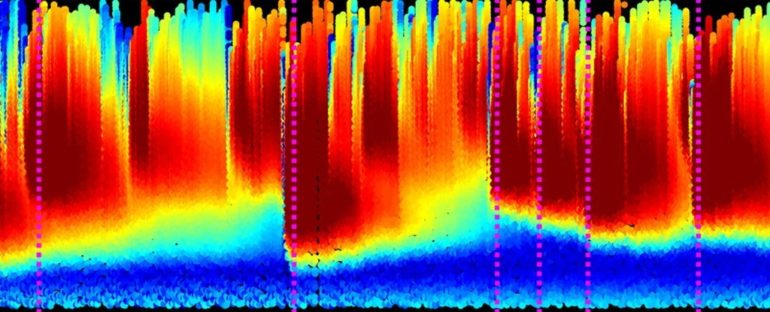When you look up at the sky, the region of space around Earth may look as clear as a song, but there’s a heck of a lot going on out there that we can’t see. In recent years, probes studying radiation trapped by Earth’s magnetic field have found something peculiar – electrons zipping along at close to light speed.
That alone isn’t the peculiar part; near-light-speed, or relativistic, electrons are well known in the cosmos, boosted by cosmic particle accelerators. The peculiar thing was that occasionally extra fast, ultrarelativistic electrons appear – but only during some solar storms, and not others.
A team of scientists led by space physicist Hayley Allison of the GFZ German Centre for Geosciences in Germany have just figured out why. And it all has to do with invisible, particle-filled radiation belts wrapped around Earth.
Only if plasma has been significantly depleted in a radiation belt before a Solar Storm can electrons achieve those ultrarelativistic speeds, the researchers have found.
Officially known as Van Allen radiation belts, these belts are located in the pocket of space almost immediately surrounding Earth. The inner belt extends from 640 to 9,600 kilometres (400 to 6,000 miles) in altitude, and the outer belt from about 13,500 to 58,000 kilometres. What they are is regions in which Earth’s magnetic field traps charged particles from the solar wind.
Here on Earth, these regions won’t noticeably affect our day-to-day lives (although we’d certainly notice if they went away and the solar wind could freely pelt us with charged particles), but the region of space immediately around the planet, out to an altitude of about 2,000 kilometres, is where we put most of our satellites. This is where knowing what sort of space weather can produce ultrarelativistic electrons could be useful.
When accelerated to such high speeds, these electrons become a hazard. Due to their high energies, not even the best shielding can keep them out, and their charge when they penetrate spacecraft can destroy sensitive electronics.
So Allison and her team set about analysing data from the Van Allen probes, twin spacecraft launched to study the Van Allen belts in 2012 (before being deactivated in 2019).
During this time, the probes recorded several solar storms, intense events in which an outburst from the Sun buffets the terrestrial magnetosphere with solar wind and radiation.
They were looking to discover why some of these storms resulted in ultrarelativistic electrons, and others did not. In particular, they wanted to examine the plasma.
Plasma waves – fluctuations in the electric and magnetic fields – are known to have an accelerating effect on electrons, which can “surf” the plasma waves like a wakesurfer uses water waves to accelerate.
And solar storms are known to excite plasma waves around Earth; in fact, the Van Allen probes contributed to the discovery that the so-called “chorus” plasma waves around Earth can accelerate electrons, although the effect alone was thought insufficient to explain the observed ultrarelativistic electrons. Researchers thought there must be some kind of two-step acceleration process happening.
So the team compared plasma observations taken by the Van Allen probes to the solar storms, both with and without ultrarelativistic electrons, in an attempt to figure out what was going on.
Plasma density is difficult to measure directly, but the team was able to infer the density from the fluctuations in the electric and magnetic fields. And the researchers found that the ultrarelativistic electrons correlated both with an extreme depletion of the plasma density and the presence of chorus waves.
It’s a result that shows that a two-stage acceleration process, as had previously been thought responsible, is not required for ultrarelativistic electrons.
Although the team focused on the most extreme electron speeds, they also found that when plasma density was lower, the chorus waves accelerated electrons to relativistic speeds on shorter timescales than when plasma density is higher.
“This study shows that electrons in the Earth’s radiation belt can be promptly accelerated locally to ultrarelativistic energies, if the conditions of the plasma environment – plasma waves and temporarily low plasma density – are right,” explained physicist Yuri Shprits of GFZ German Centre for Geosciences and the University of Potsdam in Germany.
“The particles can be regarded as surfing on plasma waves. In regions of extremely low plasma density they can just take a lot of energy from plasma waves. Similar mechanisms may be at work in the magnetospheres of the outer planets such as Jupiter or Saturn and in other astrophysical objects.”
The research has been published in Science Advances.


